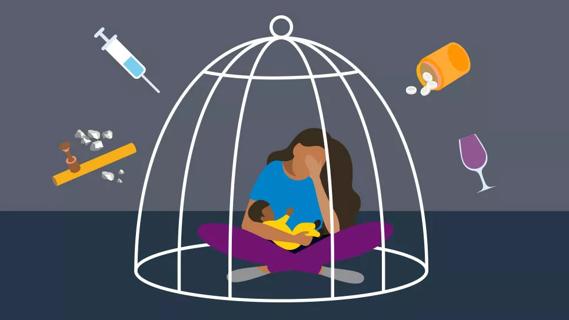From baby acne and body hair to rooting reflexes and sleeping patterns, it’s all normal

You love your child more than life itself, but let’s face it, newborns are kind of like tiny aliens, initially foreign in everything from their appearance to their behavior. Is it OK for them to have a bunch of body hair? (Yes.) Why is their head so lumpy? (We’ll get to it.) And are they supposed to be crying so much?! (Honestly, yes, probably.)
Cleveland Clinic is a non-profit academic medical center. Advertising on our site helps support our mission. We do not endorse non-Cleveland Clinic products or services. Policy
We’re here to help set your mind at ease. Pediatrician Lisa Diard, MD, explains some of the traits you can expect from your newborn — and how long it typically takes for things to change.
It’s important to know what kind of behaviors to expect from your newborn so you can tell if there’s a problem. But don’t be alarmed if your baby seems a little behind. Every baby is different!
Before we dive in, it’s also helpful to know which words define which stages of your child’s life and growth. The word “baby” is a pretty overarching term, but other words refer to specific timeframes:
Dr. Diard cautions that if your baby was born prematurely, you can’t initially compare their development to that of full-term newborns.
“Premature babies are often developmentally behind full-term babies,” she says. “If your baby was born two months early, they might be two months behind a full-term baby.”
Your baby’s doctor will follow their developmental progress, but contact them if you think your child is developing at an unusually delayed rate.
It can be hard to know what’s considered “normal” newborn behavior, especially if you’re a first-time parent (and even if you’re not!).
This list will help you understand what to expect from your baby, not just in terms of appearance, but also in terms of behaviors like their reflexes, breathing patterns, senses and more.
“You can also ask your healthcare provider about some of the things you should expect about the appearance and behavior of your new baby,” Dr. Diard says.
Certain things are normal about a newborn’s appearance, like their umbilical cord stump and slightly misshapen head. Dr. Diard walks you through what you might be able to expect, looks-wise — but again, keep in mind that not all of these possibilities will apply to every baby.
When your baby is born, your healthcare provider will cut off their umbilical cord, leaving behind a small stump.
“You should never try to remove this stump on your own,” Dr. Diard cautions. “It will dry up on its own and fall off naturally within a few weeks.”
Keep the stump clean and dry to prevent infections while you wait for it to fall off. This usually happens in 10 to 14 days, but it might not happen until the fourth week.
Surprised to see that your newborn is hairier than you expected … and not just on their head?! That’s normal — and it will go away pretty quickly.
“Parts of your newborn’s body might be covered in fine hairs, like their shoulders, back, temples or ears,” Dr. Diard notes. “This hair protects them in the uterus but is usually shed within the first week after they’re born.”
This fine hair, called lanugo, helps keep them safe and warm while they’re developing in the uterus. It also helps a white, creamy substance called vernix to stick to their skin and give them extra protection. Vernix is washed off when they’re born, but it can take about a week for babies to shed their lanugo.
The term “baby soft” is sometimes used to refer to things that are as smooth as a newborn baby’s skin. But as it turns out, newborns’ skin isn’t always as soft or smooth as you’d expect.
Here are some common skin issues you may notice:
Babies are often born with swollen or bumpy noggins, and it’s usually nothing to worry about. The top of their head might look swollen, or they could have smaller lumps elsewhere on their skull.
“This is caused either from fluid forced into the scalp at birth or from the baby rubbing up against the birth parent’s pelvic bones,” Dr. Diard explains. “Swelling at the top of the head should go down within a few days, while swelling from friction will go down within two to three months.”
Talk to your doctor if the swelling increases or lasts longer than expected.
Your baby has spent months in the very close quarters of your uterus, which can cause them to be born with turned-up feet or bow legs (knees that curve outward).
“This is caused by being held tightly in the uterus,” Dr. Daird further explains, “but they typically straighten out within six to 12 months.”
If the condition persists, talk to your pediatrician about corrective options.
Being born is hard work, and sometimes, the pressure of birth can cause a blood vessel to break in your baby’s eye. This is called a subconjunctival hemorrhage, and it looks like a red spot on the white part of the eye. But try not to worry: This isn’t uncommon, and it should heal within two to three weeks.
A baby’s tear duct can also become blocked, making their eye continuously water.
“This will usually clear up within the first year of life, but be sure to ask your child’s doctor at the next visit,” Dr. Diard advises. “Call the doctor immediately if the eye starts to look more red, swollen or has pus or a yellow drainage.”
Up to 85% of newborns have tiny cysts in their mouths called Epstein pearls. They usually appear along the gumline or on the roof of their mouth, and they typically go away within a few weeks.
Your baby’s genitals might look different from what you thought they would, but that doesn’t mean anything is wrong. Here’s what to expect and how long it usually takes for these issues to go away:
You can also expect your baby’s breasts to be swollen for two to four weeks. “This happens in both boys and girls, and it’s caused by the parent’s estrogen in the placenta,” Dr. Diard says.
Though babies develop at different rates, they still follow many of the same behaviors. To help ease your worried mind, Dr. Diard shares what to know about newborns’ reflexes, sleep habits and more.
Newborns can see movement and the contrast between black and white objects, but it’s hard for them to focus, so their eyes might be crossed at first.
“By two to three months, babies have more control of their eye muscles and are able to focus their eyes on one thing,” Dr. Diard confirms. “They can also follow objects with their eyes.”
Newborn babies can distinguish between different sounds, but when they’re this little, they hear language sort of like music — that is to say, mostly in different tones and rhythms.
“They recognize familiar voices, so you should talk to your baby often,” Dr. Diard encourages, “and you might soon find that they turn toward the sound of your voice.”
Newborns make all kinds of sounds: hiccupping, sneezing, yawning, spitting up, burping, gurgling. And, of course, they cry — sometimes, a lot.
“Newborns might cry for several hours a day,” Dr. Diard warns. “This is their way of telling you they need something or that something is wrong.” Your baby may cry when they’re:
But sometimes, newborns cry for no reason at all. “If this happens, try comforting your baby by rocking, singing, talking softly or wrapping them in a blanket,” Dr. Diard advises. “Soon you’ll be able to tell what they need by how they cry.”
Contact your provider if your newborn cries more than they normally do, if it starts to sound different or if they’re crying at different times of day than is usual for them. These could be signs that your baby is sick.
Newborns usually sleep for 20 minutes to four hours at a time, usually for 14 to 16 hours a day. Wow!
This is partly because newborns don’t have the sort of internal clock that adults do — you know, the one that tells is the difference between day and night, or when to be awake and when to sleep. They have to develop it over time.
Newborns also get too hungry to sleep through the night right away. “Their stomachs are too small to keep them full for long, so they wake up needing to be fed every few hours,” Dr. Diard states.
All babies have different sleeping habits, but at 3 months old, most babies sleep six to eight hours a night, and they typically start sleeping through the night by 6 months old.
During their first few weeks, newborns maintain the position they had in the uterus: clenched fists, arms and legs close to the front of the body, bent at the elbows, hips, and knees. This is aptly known as … the fetal position! But this will start to change as your baby develops more control over their movements.
Newborns also have several natural reflexes that may initially seem unfamiliar to you. “Understanding them will help you understand the cause of some of their behaviors,” Dr. Diard notes.
These reflexes include:
“It’s also normal for your baby’s arms, legs, and chin to tremble sometimes, especially when they’re crying,” Dr. Diard shares. “This occurs because newborns’ nervous systems are not fully developed.”
When there’s a new baby at home, you’re probably keeping a close eye out to make sure their tiny chest is still rising and falling. But it’s not uncommon for newborns to stop breathing for five to 10 seconds and then immediately begin breathing again on their own.
“It’s normal for newborns to experience irregular breathing,” Dr. Diard says. “But you should take your baby to the emergency room if they stop breathing for longer than 10 seconds or begin to turn blue.”
Another item of note: If your baby’s breathing is especially high-pitched or noisy, be sure to bring it up with your doctor. Laryngomalacia is a common type of voice box condition that some newborn babies have.
Being a parent is a lot of things: exciting, joyful, overwhelming, nerve-wracking and, yes, sometimes terrifying. If you have questions about your baby’s appearance, behavior or anything else related to their health and well-being, don’t hesitate to bring it up with your pediatrician. They’re there to help your baby thrive.
Learn more about our editorial process.

In babies under 12 months, honey may cause a serious illness called infant botulism

Lanugo — the soft, fine hair that develops in utero — is harmless and will shed within a few weeks

Crossed eyes in a newborn are fairly common, typically harmless and usually go away

Neonatal opioid withdrawal syndrome, or NOWS, can develop when a birthing parent uses opioids, nonmedical drugs or even some prescription drugs during pregnancy

Most parents report an improvement in breastfeeding, but there’s a chance the procedure won’t solve the issue

All babies go through a perfectly normal peeling phase in the first couple weeks

Tiny kidneys and tiny tummies don’t mix well with water

Be mindful about temperature, positioning and efficiency when it’s comes to your little one

Your metabolism may torch 1,300 to 2,000 calories daily with no activity

A gentle touch in all the right places may help drain your sinuses